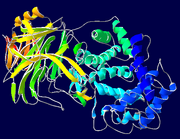One year ago, this column reviewed some of the vitamins and minerals that affect the inflammatory pathways. This month we will examine the evidence for anti-inflammatory effects from supplementation with certain other nutrients.
[ILLUSTRATION OMITTED]
Omega-3 Essential Fatty Acids
Arachidonic acid (AA), precursor to pro-inflammatory eicosanoids, is released from membrane phospholipids in the course of inflammatory activation. Encouraging results in reducing inflammatory responses have been obtained by dietary supplementation with the long-chain omega-3 fatty acid eicosapentaenoic acid (EPA). In states of inflammation, EPA competes with AA for enzymatic metabolism, inducing the production of less inflammatory derivatives. (1)
For example, in a study published in the New England Journal of Medicine, normal subjects were supplemented with a daily dose of 3.2 grams EPA or 1.8 grams of MaxEPA (a proprietary preparation) for 6 weeks. EPA in neutrophils was increased 7-fold without any increase in AA. When the neutrophils were activated, there was a 37% reduction in the release of AA and a 48% reduction in the inflammatory products of this pathway. (2)
Omega-6 Essential Fatty Acids
In general, eicosanoids formed from the omega-6 fatty acids are much more potent in causing stimulation of inflammatory responses than those formed from the omega-3 fatty acids. (3) Sources of the omega-6 fatty acid gamma-linolenic acid (GLA) have demonstrated significant anti-inflammatory effects, even though GLA is a precursor to pro-inflammatory AA.
Following GLA supplementation, its metabolite dihomogammalinolenic acid (DGLA), but not AA, accumulates in neutrophil glycerolipids. This increase in DGLA relative to AA within inflammatory cells may attenuate the biosynthesis of AA metabolites and represent a mechanism by which dietary GLA exerts its anti-inflammatory effect. (4) GLA supplementation also decreases the capacity of polymorphonuclear cells to generate pro-inflammatory leukotriene B4 in parallel to the increase in DGLA. (5) While the most effective dosage is not well established, one gram of GLA supplementation daily appears to be reasonable.
Flavonoids
In animal studies, various flavonoids have shown potent anti-inflammatory activity. (7) They may inhibit arachidonic acid metabolism, (8) inhibit histamine release from basophils (Middleton) and mast cells, (9) and decrease neutrophil lysosomal enzyme secretion to stabilize cell membranes and decrease lipid peroxidation, leukotriene release, and collagen breakdown by hyaluronidase. (10)
Quercetin is one of the most promising of the flavonoids. In both in vitro (testtube) (11) and animal (12) studies, it has shown anti-inflammatory effects. Its efficacy in treating inflammation in human subjects remains to be shown, however. The usual dosage range is 200 to 400 mg 2 to 3 times daily.
L-Glutamine
Glutamine, the most plentiful amino acid in the blood, has traditionally been thought of as nonessential. However, laboratory and clinical data suggest that it may be essential during certain inflammatory conditions during which its consumption may outstrip endogenous production and a relative glutamine deficiency state may exist.
The results of both animal and clinical studies suggest that inflammatory responses may be reduced by providing enough supplementary glutamine to achieve adequate tissue concentrations. (13) Although its mechanism of action is not well understood, we know that the production of nitric oxide contributes to inflammation and pain, while L-glutamine has been shown to inhibit the generation of nitric oxide from L-arginine in endothelial cells. (14)
In animal studies, L-glutamine was effective orally in suppressing various experimentally-induced inflammatory reactions and did not show any gastric irritation in anti-inflammatory doses. (15) For supplementation to be beneficial, divided doses of somewhere between 500 and 1500 mg 3 times daily may be needed.
References
1. Heller A et al. Lipid mediators in inflammatory disorders. Drugs 55(4):487-96, 1998
2. Lee TH et al. Effect of dietary enrichment with eicosapentaenoic acid and docosahexaenoic acids on in vitro neutrophil and monocyte leukotriene generation and neutrophil function. N Engl J Med 312:1217-23, 1985
3. Alexander JW. Immunonutrition: the role of omega-3 fatty acids. Nutrition 14(7-8):627-33, 1998
4. Johnson MM et al. Dietary supplementation with gamma-linolenic acid alters fatty acid content and eicosanoid production in healthy humans. J Nutr 127(8):1435-44, 1997
5. Ziboh VA, Fletcher MP. Dose-response effects of dietary g-linolenic acid-enriched oils on human polymorphonuclear-neutrophil biosynthesis of leukotriene B4. Am J Clin Nutr 55:39-45, 1992
6. Pelzer LE et al. Acute and chronic antiinflammatory effects of plant flavonoids. Farmaco 53(6):421-4, 1998
7. Ferr[double dagger]ndiz ML, Alcaraz MJ. Anti-inflammatory activity and inhibition of arachidonic metabolism by flavonoids. Agents Actions 32(3-4):283-8, 1991
8. Middleton E, Drzewieki G. Naturally occurring flavonoids and human basophil histamine release. Arch Allergy Appl Immunol 77:155-57, 1985
9. Amella M et al. Inhibition of mast cell histamine release by flavonoids and bioflavonoids. Planta Medica 51:16-20, 1985
10. Busse WW et al. Flavonoid modulation of human neutrophil function. J Allergy Clin Immunol 73:801-9, 1984
11. Skaper SD et al. Quercetin protects cutaneous tissue-associated cell types including sensory neurons from oxidative stress induced by glutathione depletion: cooperative effects of ascorbic acid. Free Radic Biol Med 22(4):669-78, 1997
12. Camalada M et al. In vivo quercitrin anti-inflammatory effect involves release of quercetin, which inhibits inflammation through down-regulation of the ND-kappaB pathway. Eur J Immunol 2005 Feb; 35(2):584-92.
13. Wilmore DW, Shabert JK. Role of glutamine in immunologic responses. Nutrition 14(7-8):618-26, 1998
14. Meininger CJ, Wu G. L-glutamine inhibits nitric oxide synthesis in bovine venular endothelial cells. J Pharmacol Exp Ther 281(1):448-53, 1997
15. Jain P, Khanna NK. Evaluation of anti-inflammatory and analgesic properties of L-glutamine. Agents Actions 11(3):243-9, 1981
by Melvyn R. Werbach, MD
4751 Viviana Drive * Tarzana, California 91356 USA
Phone 818-996-0076 * Fax 818-774-1575
Doctor Werbach cautions that the nutritional treatment of illness should be supervised by physicians or practitioners whose training prepares them to recognize serious illness and to integrate nutritional interventions safely into the treatment plan.
Doctor Werbach's voluminous Nutritional Influences on Illness CD-ROM, with 4,200 pages of text and covering over 100 different illnesses, makes it easy to search the nutritional literature. For information, contact Third Line Press Inc., 4751 Viviana Drive, Tarzana, California 91356 USA. (Tel: 800-916-0076; 818-996-0076; FAX: 818-774-1575; E-mail: tlp@third-line.com; Internet: http://www.third-line.com).
COPYRIGHT 2005 The Townsend Letter Group
COPYRIGHT 2005 Gale Group



